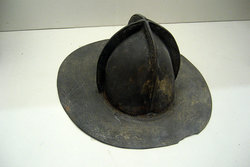In 1737 it was determined that more organization had to be imposed on the use of these engines at fires, so the General Assembly passed a law to appoint up to forty-two "strong, able, discreet, honest and sober men…[who] shall be called Firemen of the City of New York." Turk was one of the first thirty men to be appointed. He continued in his role as Overseer until 1761 when his brother-in-law and fellow gunsmith, Jacobus Stoutenburgh, took over.
As simple as the early structures in the City and the fire engines to fight fires in them were, the dangers faced by firemen were great. Some time around 1740, Turk used his skills to fashion a hat, or helmet, of hardened leather that could be worn by the firemen to afford them some degree of protection. He is therefore credited with creating perhaps the most critical piece of firefighter safety. The concepts that he used in designing his helmet form the basis of helmets still used by the FDNY and the majority of fire services today.
Exactly when Jacobus Turck departed this life and where he was interred has not been uncovered. His will was described in a newspaper on February 22, 1780, indicating he died not long before that date.
Any assistance with further information on his birth/death dates or his final resting place would be greatly appreciated.
In 1737 it was determined that more organization had to be imposed on the use of these engines at fires, so the General Assembly passed a law to appoint up to forty-two "strong, able, discreet, honest and sober men…[who] shall be called Firemen of the City of New York." Turk was one of the first thirty men to be appointed. He continued in his role as Overseer until 1761 when his brother-in-law and fellow gunsmith, Jacobus Stoutenburgh, took over.
As simple as the early structures in the City and the fire engines to fight fires in them were, the dangers faced by firemen were great. Some time around 1740, Turk used his skills to fashion a hat, or helmet, of hardened leather that could be worn by the firemen to afford them some degree of protection. He is therefore credited with creating perhaps the most critical piece of firefighter safety. The concepts that he used in designing his helmet form the basis of helmets still used by the FDNY and the majority of fire services today.
Exactly when Jacobus Turck departed this life and where he was interred has not been uncovered. His will was described in a newspaper on February 22, 1780, indicating he died not long before that date.
Any assistance with further information on his birth/death dates or his final resting place would be greatly appreciated.
Family Members
Advertisement
Records on Ancestry
Advertisement





